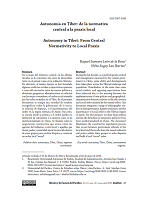Autonomy in Tibet: From Central Normativity to Local Praxis
DOI:
https://doi.org/10.32870/mycp.v12i34.814Keywords:
autonomy, Tibet, China, Autonomous RegionsAbstract
During the last decades, as a result of greater control and management exercised by the central government in China, some shifts and developments have taken place across the Tibetan landscape and population. Nonetheless, at the same time some social conflicts and opposing expectations have been inherited due to the meeting between the implementation of new policies and geographical-administrative divisions relative to the old customs and social order retained by the nomad tribes. This document integrates a range of ethnographic studies on land governance, dispute resolution, and the maintenance of social order in the Tibetan region of Amdo. For this purpose, we draw from politics and law the definition of autonomy and how it has been institutionalized in China. The document illuminates the constructive negotiation process that occurs between government officials at the local level and those who have the moral authority and power within these groups to solve disputes and build a local “moral” order.Downloads
References
Ahlers, A., & Schubert, G. (2015). Effective Policy Implementation in China’s Local State. Modern China, 41(4), 372-405. https://doi.org/10.1177/0097700413519563
Barter, S. J. (2018). Rethinking territorial autonomy. Regional Studies, 52(2), 298–309. https://doi.org/10.1080/00343404.2017.1366651
Buffetrille, K. (Ed.). (2012). Revisiting Rituals in a Changing Tibetan World. Brill. Buzan, B. (1991). The idea of the state and the national security. En R. Little & M. Smith (Eds), Perspectives on World Politics (pp. 33-46). Routledge. https://doi.org/10.4324/9780203300527
Cencetti, E. (2014). New Settlements on the Tibetan Plateau of Amdo-Qinghai: Spatialized Power Devices. En: T. Brox & I. Bellér-Hann (Eds.), On the Fringes of the Harmonious Society: Tibetans and Uyghurs in Socialist China (pp. 159-182). NIAS Press.
Cencetti, E. (2015). Phayul: An Analysis of Grassland Management Policies in Amdo-Qinghai. Nomadic Peoples, 19(2), 303-323.
Centre for China Analysis and Strategy. (2017). The Tibet Insight News. https://ccasindia.org/tibat-insight-5.php?tid=916
Chen, J., & Huhe, N. (2013). Informal Accountability, Socially Embedded Officials, and Public Goods Provision in Rural China. Journal of Chinese Political Science, (18), 101-116. https://doi.org/10.1007/s11366-013-9237-3
Constitute Project. (2021). Constitución de China, 1982, con enmiendas hasta 2004. https://www.constituteproject.org/constitution/China_2004. pdf?lang=es
Congressional-Executive Commission on China. (2006). Regional Ethnic Autonomy Law of the People’s Republic of China. https://www.cecc.gov/resources/legal-provisions/regional-ethnic-autonomy-law-of-the-peoplesrepublic-of-china-amended
de Blas Guerrero, A. (1986). Elementos constitutivos del Estado. En R. García Cotarelo (Comp.), Introducción a la Teoría del Estado (85-112).Teide.
Fernández Santillán, J. (Comp). (2000). Norberto Bobbio: el filósofo y la política:
antología (Trads. J. Fernández Santillán & A. Aureli). Fondo de Cultura Económica.
Fischer, A. M. (2004). Urban Fault Lines in Shangri-La: Population and Economic Foundations of Inter-Ethnic Conflict in Tibetan Areas or Western China (Crisis States Programme Working Paper No. 42). London School of Economics and Political Science. https://www.lse.ac.uk/international-developmentAssets/Documents/PDFs/csrc-working-papers-phase-one/wp42-urbanfaultlines-in-shangri-la.pdf
Fischer, A. M. (2009). The Political Economy of Boomerang Aid in China’s Tibet. China Perspectives, 3, 38-54. https://doi.org/10.4000/chinaperspectives.4842
Foreign Ministry People’s Republic of China. (2004). National Minorities Policy and Its Practice in China. https://www.fmprc.gov.cn/ce/cgvienna/eng/ljzg/zfbps/t127407.htm
Ghai, Y. (2000). Ethnicity and Autonomy: A Framework for Analysis. En Y. Ghai (Ed.), Autonomy and ethnicity: Negotiating Competing Claims in Multiethnic States (pp. 1–26). Cambridge University Press.
Harrell, S. (2001). Ways of Being Ethnic in Southwest China. Seattle: University of Washington Press. https://doi.org/10.6069/9780295804071
Hillman, B. (2005). Monastic Politics and the Local State in China: Authority and Autonomy in an Ethnically Tibetan Prefecture. The China Journal, (54), 29-51. https://doi.org/10.2307/20066065
Hillman, B. (2010). China’s many Tibets: Diqing as a model for ‘development with Tibetan characteristics?’ Asian Ethnicity, 11(2), 269-277. https://doi.org/10.1080/14631361003779604
Horlemann, B. (2002). Modernization Efforts in Mgo log: A Chronicle, 1970-2000. En: T. Huber (Ed.), Amdo Tibetans in Transition: Society and Culture in the Post-Mao Era (pp.241-269). Brill.
Levine, N. (1999). From nomads to ranchers: managing pasture among ethnic Tibetans in Sichuan. En G. E. Clarke (Ed.), Development, Society and Environment in Tibet (pp. 69-76). Verlag der Österreichschen Akademie der Wissenschaften.
Li, C. (2008). Ethnic Minority Elites in China’s Party-State Leadership: An Empirical Assessment. China Leadership Monitor, (25), 1-13. https://www.brookings.edu/wp-content/uploads/2016/06/summer_china_li.pdf
Lieberthal, K. (2004). Governing China: From Revolution through Reform (2ed.). Norton.
Márquez Restrepo, M. L. (2011). Perspectivas teóricas para abordar la nación y el nacionalismo. Papel Político, 16(2), 567-595.
Mertha, A. C. (2005). China’s ‘Soft’ Centralization: Shifting Tiao/Kuai Authority Relations. The China Quarterly, 184, 791-810. https://doi.org/10.1017/S0305741005000500
Newland, S. A. (2015). Diversity and Distribution: Essays on Local Governance and Public Service Provision in Multiethnic China [Tesis de Doctorado, University of California]. https://digitalassets.lib.berkeley.edu/etd/ucb/text/Newland_berkeley_0028E_15579.pdf
O’Brien, K. J., & Li, L. (1999). Selective Policy Implementation in Rural China. Comparative Politics, 31(2), 167-186. https://doi.org/10.2307/422143
O’Brien, K., J., & Luehrmann, L. M. (1998). Institutionalizing Chinese Legislatures: Trade-Offs between Autonomy and Capacity. Legislative Studies Quarterly, 23(1), 91-108.
Pastoralism, Uncertainty, Resilience [PASTRES]. (2020, febrero 28). Institutional Hybridity in Pastoral Land Governance in Amdo Tibet. https://pastres.org/2020/02/28/institutional-hybridity-in-pastoral-land-governancein-amdo-tibet/
Pirie, F. (2005a). Feuding, Mediation and the Negotiation of Authority among the Nomads of Eastern Tibet (Working Paper No. 72). Max Planck Institute for Social Anthropology. https://www.eth.mpg.de/cms/en/publications/working_papers/wp0072
Pirie, F. (2005b). Segmentation within the State: The Reconfiguration of Tibetan Tribes in China’s Reform Period. Nomadic Peoples, 9(1/2), 83-102. https://doi.org/10.3167/082279405781826074
Pirie, F. (2013). The Limits of the State: Coercion and Consent in Chinese Tibet. The Journal of Asian Studies, 72(1), 69-89. https://doi.org/10.1017/ S0021911812001805
Pirie, F., & Huber, T. (2008). Conflict and Social Order in Tibet and Inner Asia. Brill. https://doi.org/10.1163/ej.9789004158177.i-274.2
Potter, P. B. (2011). Law, Policy and Practice on China’s Periphery: Selective Adaptation and Institutional Capacity. Routledge.
Ptackova, J. (2011). Sedentarisation of Tibetan nomads in China: Implementation of the Nomadic settlement project in the Tibetan Amdo area: Qinghai and Sichuan Provinces. Pastoralism: Research, Policy and Practice, 1(4). https://doi.org/10.1186/2041-7136-1-4
Ranade, J. (2018). Cadres of Tibet. KW Publishers.
Rossabi, M. (Ed.). (2004). Governing China’s Multiethnic Frontiers. University of Washington Press. https://doi.org/10.6069/9780295804057
Sautman, B. (1999). Ethnic Law and Minority Rights in China: Progress and Constraints. Law and Policy, 21(3), 283-314. https://doi.org/10.1111/1467-9930.00074
Scoones, I. (2018, noviembre 30). Negotiating Uncertainties on the Tibetan Plateau in China. PASTRES. https://pastres.org/2018/11/30/negotiatinguncertainties-on-the-tibetan-plateau-in-china/
Smith, A. D. (2000). Nacionalismo y Modernidad. Ediciones Istmo.
Tsai, L. L. (2002). Cadres, Temple and Lineage Institutions, and Governance in Rural China. The China Journal, (48), 1-27. https://doi.org/10.2307/3182439
Tsai, L. L. (2007). Accountability without Democracy: Solidarity Groups and Public Goods Provision in Rural China. Cambridge University Press. https://doi.org/10.1017/CBO9780511800115
Wu, D. (1990). Chinese Minority Policy and the Meaning of Minority Culture: The Example of Bai in Yunnan, China. Human Organization, 49(1), 1-13. https://doi.org/10.17730/humo.49.1.h1m8642ln1843n45
Yang, Y., Liang, F., Quan, F., Jiang, G., Yu, K., & Zheng, Y. (2019). The Importance of Ethnicity: Developing a Measure of Minority Ethnic Value and Value-Expressive Behavior among Chinese Ethnic Minorities. Frontiers in Psychology, 10(2603), 1-18. https://doi.org/10.3389/fpsyg.2019.02603
Yeh, E. T. (2003). Tibetan Range Wards: Spatial Politics and Authority on the Grasslands of Amdo. Development and Change, 34(3), 499-523. https://doi.org/10.1111/1467-7660.00316
Yuan, H. (2008). Chinese Ethnicities and their Culture: An Overview (Paper 23). DLPS Faculty Publications. https://digitalcommons.wku.edu/dlps_fac_pub/23/
Zhao, T. (2021). The Cadre System in China’s Ethnic Minority Regions: Particularities and Impact on Local Governance. Journal of Contemporary China, 30(132), 945-959. https://doi.org/10.1080/10670564.2021.1893559

Downloads
Published
Versions
- 2023-02-20 (4)
- 2022-12-16 (3)
- 2022-12-15 (2)
- 2022-12-15 (1)
How to Cite
Issue
Section
License
Copyright (c) 2022 México y la Cuenca del Pacífico

This work is licensed under a Creative Commons Attribution-NonCommercial 4.0 International License.
Open Access Policy
This journal provides open access to all its contents, in adherence to the principle that making research freely available supports a greater global exchange of knowledge.
MyCP is licensed under a Creative Commons Attribution-NonCommercial license, also known as CC BY-NC.
Contents are published in both PDF and XML formats.
Authors who publish in México y la Cuenca del Pacífico must accept the following conditions:
Pursuant to Mexican copyright laws, México y la Cuenca del Pacífico acknowledges and respects the authors’ moral right and ownership of property rights, which will be assigned to the University of Guadalajara to publish the articles in an open-access mode.
México y la Cuenca del Pacífico does not charge the authors any fees for receiving and processing their articles.
Authors are permitted to enter into other independent and additional contractual agreements for the non-exclusive distribution of the article version published in México y la Cuenca del Pacífico (for example, publishing it in an institutional repository or in other printed or electronic media) as long as they clearly state that the piece was originally published in México y la Cuenca del Pacífico.
Pursuant to the above, once the article is approved for publication, authors must send the Assignment of Rights Agreement form duly filled and signed. This form must be sent to mexicoylacuenca@gmail.com as a PDF file.
Readers/users of México y la Cuenca del Pacífico can freely access the journal new issues as soon as they are uploaded. Readers/users are allowed to cite, share (both electronically and physically), print and distribute the material, provided they expressly state that the work was originally published in México y la Cuenca del Pacífico. Contents are to be properly cited and never for commercial purposes.




